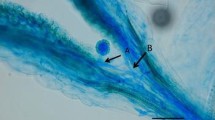Summary
The nature and process of ovular incompatibility in Gasteria verrucosa was studied. Using different crossing programs and following the pollen germination and ovule penetration histochemically, an ovular gametophitic incompatibility system based on two or more loci is affirmed. Pollen tubes after self-and cross-pollination penetrate the micropyle. Although the percentage of seed setting reached about 60% after cross pollination no clear differences could be seen between the germination and ovule penetration of cross and self pollen.
In the ovules, multiple penetration of micropyles and a preference for the first position ovules was observed. Results of semi-compatible crossings and mixed crossings indicated a gametophytic two or more loci incompatibility system. Ovular incompatibility was manifested by the degeneration of the sporophytic ovular tissues. In Gasteria verrucosa the system of ovular incompatibility does not seem to be restricted to the ovule.
Similar content being viewed by others
References
Brandham, P.E. & S.J. Owens, 1978. The genetic control of self-incompatibility in the genus Gasteria (Liliaceae). Heredity 40: 165–169.
Brewbaker, J.L. & J.H. Kwack, 1964. The calcium ion and substances influencing pollen growth. In: H.F. Linskens (Ed.). Pollen Physiology and Fertilization. North-Holland publishing company, Amsterdam: 143–151.
Brewbaker, J.L. & D.D. Gorrez, 1967. Genetics of self-in-compatibility in the monocot genera, ananas (pineapple) and Gasteria. Amer. J. Bot. 54: 611–616.
Cope, F.W., 1962. The mechanism of pollen incompatibility in Theobroma cacao L. Heredity 17: 157–182.
Jensen, W.A., 1962. Botanical Histochemistry. W.H. Freeman and Company, San Francisco. 408 p.
Nettancourt, D. de, 1977. Incompatibility in Angiosperms. Springer Verlag, Berlin-Heidelberg-New York. 230 p.
Sears, E.R., 1937. Cytological phenomena connected with self-sterility in the flowering plants. Genetics 22: 130–181.
Seavey, S.R. & K.S. Bawa, 1986. Late-acting self-incompatibility in Angiosperms. Botanical Review 52: 195–219.
Willemse, M.T.M. & M.A.W. Franssen-Verheijen, 1986. Stylar development in the open flower of Gasteria verrucosa (Mill.) H. Duval. Acta Bot. Neerl. 35: 297–309.
Willemse, M.T.M. & M.A.W. Franssen-Verheijen, 1988. Pollen tube growth and its pathway in Gasteria verrucosa (Mill.) H. Duval. Phytomorphology 38: 127–132.
Willemse, M.T.M. & C.J. Keijzer, 1990. Tracing pollen nuclei in the ovari and ovule of Gasteria verrucosa (Mill.) H. Duval after pollination with DAPI-stained pollen. Sex. Plant Reprod. 3: 219–224.
Author information
Authors and Affiliations
Rights and permissions
About this article
Cite this article
Naaborgh, A.T., Willemse, M.T.M. The ovular incompatibility system in Gasteria verrucosa (Mill.) H. Duval. Euphytica 58, 231–240 (1991). https://doi.org/10.1007/BF00025254
Received:
Accepted:
Issue Date:
DOI: https://doi.org/10.1007/BF00025254




